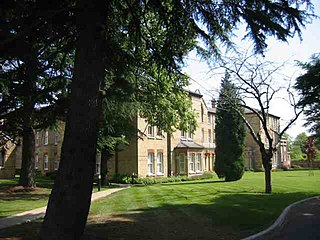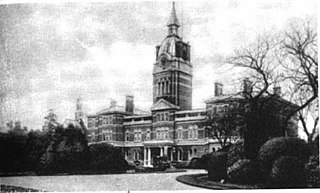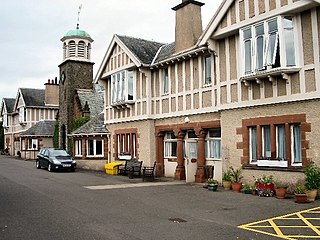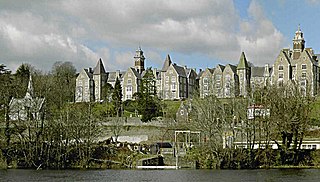
Friern Hospital was a psychiatric hospital in the parish of Friern Barnet close to a crossroads which had a hamlet known as Colney Hatch. In 1965, it became part of the London Borough of Barnet and in the early 21st century was converted to residential housing as Princess Park Manor and Friern Village. The hospital was built as the Second Middlesex County Asylum and was in operation from 1851 to 1993. After the County of London was created in 1889 it continued to serve much of Middlesex and of the newer county, London. During much of this time its smaller prototype Hanwell Asylum also operated.
George Thomas Hine FRIBA was an English architect. His prolific output included new county asylums for Hertfordshire, Lincolnshire, Surrey, East Sussex and Worcestershire, as well as extensive additions to many others.

Mendota Mental Health Institute (MMHI) is a public psychiatric hospital in Madison, Wisconsin, United States, operated by the Wisconsin Department of Health Services. The hospital is accredited by the Joint Commission. Portions of the facility are included in the Wisconsin Memorial Hospital Historic District, District #88002183. The Mendota State Hospital Mound Group and Farwell's Point Mound Group are also located at the facility.

Charlton Down is a new village in Dorset, England, situated approximately 4 miles (6.4 km) north of the county town Dorchester. It lies within the civil parish of Charminster.

Stone House Hospital was a hospital and former mental illness treatment facility in Stone, near Dartford, Kent, in the United Kingdom.

Leavesden Mental Hospital was a mental health facility at Leavesden on the outskirts of Abbots Langley in Hertfordshire.

Central State Hospital, originally known as the Central Lunatic Asylum, is a psychiatric hospital in Petersburg, Virginia, United States. It was the first institution in the country for "colored persons of unsound mind".

Roundway Hospital was a psychiatric hospital in the parish of Roundway near Devizes, Wiltshire, England. It was originally called the Wiltshire County Lunatic Asylum and later the Wiltshire County Mental Hospital. It opened in 1851 and closed in 1995.

Hellesdon Hospital is a mental health facility in Hellesdon, Norfolk, England. It is managed by Norfolk and Suffolk NHS Foundation Trust.

Prestwich Hospital is a mental health facility in Prestwich, Greater Manchester, England.

Banstead Hospital, also known as Banstead Asylum, was a psychiatric hospital in the village of Belmont, Sutton, adjacent to Banstead.

Kingsway Hospital was a mental health facility in Derby, England.

Mapperley Hospital was a mental health facility on Porchester Road in Nottingham, England.

Moorhaven Hospital, built as Plymouth Asylum and initially named the Plymouth Borough Asylum, was a mental health facility in Ivybridge, Devon, England.

The Coppice Hospital was a mental health facility in Mapperley, Nottingham, England.

St Matthew's Hospital, formerly known as the Burntwood Asylum, was a mental health facility in Burntwood, Staffordshire, England. Founded as the Second Staffordshire County Asylum in 1864, it was one of three lunatic asylums built in the county of Staffordshire. The plan was for the asylum to house 500 patients, but it was later expanded to provide a capacity for 1302 beds. The asylum complex included the main facility, an electricity plant, gas works, bakery, fire department, farm, mortuary, landscaped and vegetable gardens and cemetery.

The Towers Hospital was a mental health facility in Humberstone, Leicestershire, England. The administration building, which became known as George Hine House, is a Grade II listed building. The property, which was originally a home on a family estate owned by the Broadbent family was transformed into what would become the hospital after being sold to the Leicestershire Council in 1862. Adjacent to the main building is Benjamin Court which is named after the original owner, Benjamin Broadbent.

The Murray Royal Hospital is a mental-health facility in Perth, Scotland. It is managed by NHS Tayside. The original main building is a Category A listed building.

Our Lady's Hospital was a psychiatric hospital in Cork, County Cork, Ireland.

The Knockbracken Healthcare Park is a mental health facility based on the Saintfield Road, Belfast, Northern Ireland. It is managed by the Belfast Health and Social Care Trust.




















